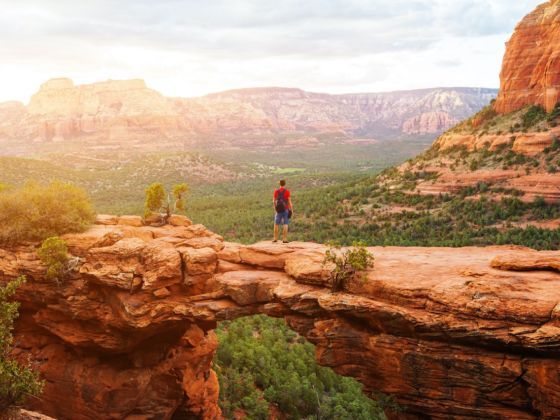1. Riding a mule into the Grand Canyon
Mules have transported visitors from the South Rim of the Grand Canyon down the rugged Bright Angel Trail for over a century. “There’s been no fatalities on mule-back and we’d like to keep it that way,” the tough-talking guide announces as you saddle up for the journey. You’ll be coached on how to keep your animal companion at just the right distance from other riders in the group as you bump along steep slopes, skinny rock passageways, and the suspension bridge over the Colorado River.
It’s a 5.5-hour trip to Phantom Ranch (with several rest stops along the way), and once at the base you’ll be met with a series of cabins with bunkbeds and hot showers. Dinner is stew or steak served family-style ’round the picnic table, but make sure you get some rest. Tomorrow you’ll be steering your mule out of the canyon upwards.
2. Walking in Tucson’s All Souls Procession
Honoring the Mexican holiday Día de los Muertos, Tucson’s All Souls Procession doesn’t require you to paint your face in the traditional skull motif, but why not? Marching through the streets, you’ll encounter mariachi bands, skeleton bird puppets, social activists, bagpipe players, and community members carrying framed photos of lost loved ones. The procession tours the city as volunteers collect hopes and wishes on prayer cards from passersby. The movement reaches a crescendo at a massive four-tiered platform topped by a giant urn where the prayer cards are set on fire, releasing their written offerings.
During the burning, the performers of Flam Chen hang from aerial apparatuses while singers and drummers ring out their reverence over a crowd of 100,000. Rebirth takes place as the slideshow of projected faces — those who have passed to the other side — dim. Then dance music cranks up in the Mercado San Agustin, a public market, and the city celebrates life anew.
3. Feeling the energy of Sedona’s vortexes
Surrounded by red sandstone buttes, crumbling spires, and towering mesas, the desert city of Sedona is known for its stunning scenery. But to the New Age set, Sedona’s beauty lies in what can’t be seen: its vortexes, heightened fields of cosmic energy said to radiate the power of the earth like a tornado or water swirling down a drain. This phenomenon is believed to facilitate prayer, meditation, and the healing of body and soul; many Phoenicians make the two-hour drive north to the red rocks to “clean out” the residue generated by city living.
If all that’s a bit too far out for you, come to one of Sedona’s four vortex locations at sunrise or sunset anyway. Maybe you won’t feel the subtle vibrations the guy next to you is whooping for joy over, but you’re in for an incredible light show as the sun turns the desert peaks orange and blood red.
4. Holding a séance at Tombstone’s Bird Cage Theatre
Even after the fire of 1882 and the silver mining bust, the Bird Cage Theatre stands as a rare original from the Wild West. Operational from 1881 to 1889, this bordello housed the “soiled doves” — women who came from as far as the East Coast to find adventure as performer prostitutes when Tombstone’s streets were bustling with money and gunfire.
While the museum-like parlor is packed with poker paraphernalia and strange relics like the mythic merman, the hidden boudoirs hold the Victorian-era wooden beds of those private and pricey affairs. Most tours finish with the ghost-hunting crowd begging the tour guide for an “authentic” séance on the theater stage, but scarier still is imagining the real courtesans pulling off a turn-of-the-century can-can routine while bullets buzzed under their petticoats.
5. Gazing deep into the universe at Kitt Peak National Observatory
Situated at the apex of the 7,000-foot Quinlan Mountains on the Tohono O’odham Reservation, the Kitt Peak National Observatory has the world’s largest collection of telescopes. The 25-minute drive from the base provides some of the clearest mountain views in Arizona, but it’s the telescopes in the Nightly Observing Program that illuminate the desert sky’s star clusters and shooting comets. The program runs every night outside of monsoon season (July 15 – September 1), and the Tohono O’odham people will often have food vending in the area, or you can submit a request for a night lunch of deli sandwiches for your visit.
6. Visiting the resurrected ghost town of Jerome
Perched 5,000 feet up Cleopatra Hill in the Black Hills of Yavapai County, the old copper mining town of Jerome boomed right up until 1953, when the last of the copper deposits ran dry and the population plummeted from 15,000 to under 100 faster than you can say, “Ghost Town!” But Jerome didn’t stay quiet for long.
The ‘60s brought hippies who snapped up the town’s crumbling buildings at rock-bottom prices, and today’s population of 455 is a mix of craftspeople, chefs, writers, and artisans who’ve made a name for Jerome as a thriving artists’ colony known for its galleries, coffeehouses, and restaurants. Still, you can see vestiges of the mining period as you wander the town’s streets from the Connor Hotel over to Belgian Jenny’s Bordello Pizzeria and up to the Haunted Hamburger.
7. Stepping into the 18th-century Mission San Xavier Del Bac
When Spanish colonists moved northward from Mexico into Arizona, claiming land for New Spain, Roman Catholic priests did their part by founding a series of missions along the Sonoran Desert mountain ranges. Perhaps the most beautiful of these colonial churches is Mission San Xavier Del Bac, just 8 miles south of downtown Tucson on the San Xavier Indian Reservation. Largely built by the Tohono O’odham people under order of Jesuit explorer Eusebio Francisco Kino, the mission was completed in 1797 by the Franciscans.
Today it’s a pilgrimage site visited by thousands each year, and inside the gift shop you’ll find silver charms in the shape of various body parts — eyes, arms, heads, hearts. “Milagros,” says the shopkeeper, “they’re miracles. People buy a charm to represent the body part that ails them, and leave them at the base of the Virgin’s statue for healing.” The best view of the mission is from the adjacent hilltop, where a replica of Our Lady of Lourdes is enshrined in the rocks.
8. Touring Frank Lloyd Wright’s Taliesin West
Recognized as the “the greatest American architect of all time” by the American Institute of Architects, Frank Lloyd Wright chose to build his winter home and studio in the Sonoran Desert. Constructed between 1938 and 1940 in the foothills of Scottsdale’s McDowell Mountains, Taliesin West showcases Wright’s philosophy of “organic architecture” — local stone was used for the foundations, and glass walls integrate indoor and outdoor spaces. It now functions as the headquarters of the Frank Lloyd Wright Foundation and School of Architecture, and various tours of the buildings are run daily.
9. Discovering “The Thing” on a throwback road trip
At I-10 roadside attraction The Thing (aka, the “Mystery of the Desert”), just outside of Tucson, pay your $1 entry fee and head through the doors at the back of the service station. The painted footprints will lead you through a series of metal barns that house a bizarre collection of antique guns, animal hides, replicas of torture devices, and a 1937 Rolls Royce touted as Hitler’s automobile.
The collection is testament to a lost history when sideshows — rather than American Horror Story — fed our macabre curiosities. At the end of the footsteps you’ll approach the true Mystery of the Desert, what appears to be a Madonna tableau in a coffin — a mummified mother and child. Is it real? What is its purpose? Find out for yourself.
10. Eating the hottest food in the Southwest at Los Dos Molinos
Located in an hacienda that was once home to silent-era-western actor Tom Mix, the original Los Dos Molinos on 8646 South Central Avenue in Phoenix sells authentic New Mexican food like adovada ribs. The restaurant’s title references two chile grinders and serves as a warning — this food is hot! Owner Victoria Chavez states on the menu, “I’m sorry we do not provide a mild sauce. I do not know how to make ‘Mild.’” Chavez is the chef of the restaurant, preparing the dishes alongside her daughters. Try the shrimp Veracruz, which is served in a red chile sauce over rice with beans.
11. Sleeping in the haunted Hotel Monte Vista on Route 66
The classic neon sign has been beckoning weary travelers off Route 66 for the better part of a century. Opened in 1927, this historic haunt sits in downtown Flagstaff’s Heritage Square, and was once where Mary Costigan — the second woman in the world to be issued a radio license — hosted her daily broadcasts.
Bootlegging was rife here during Prohibition, and when Hollywood began filming movies in Northern Arizona during the ’40s and ‘50s, the Monte Vista was the hotel of choice for stars like Gary Cooper, Carole Lombard, John Wayne, Clark Gable, and Humphrey Bogart. But the patrons who refuse to leave aren’t Hollywood’s elite. Reports of the Phantom Bellboy announcing “room service” and a woman sitting in a rocking chair in Room 305 are well documented.
12. Visiting an up-and-coming U.S. wine region
Arizona has arrived on the wine scene with vineyards producing high-quality, intensely flavored grapes that thrive in the state’s arid, sunny climate. The Verde Valley Wine Trail is made up of four wineries and tasting rooms that run from Cottonwood to Cornville. At Oak Creek Vineyards, sample the Syrah and Merlots, distinctive due to their high sugar content. Javelina Leap Vineyards is the place to try award-winning Zinfandel.
Off the wine trail, the annual Prickly Pear Festival in Superior will help you hone your own skills with traditional classes on wine- and mead-making using the cacti’s ruby red fruit. And hip wine bar and winery Su Vino, in Scottsdale’s Arts District, sells a chocolate-infused wine called Porto Cocoa that’s as delicious as drinking dessert.
13. Seeing the original Mel’s Diner sign
Driving along NW Grand Avenue in Phoenix, you’ll spot the giant coffee cup spilling out an arrow that points to Mel’s Diner. While the beloved 1970s American sitcom Alice was filmed in a Burbank studio, you can still get a retro diner experience where the original sign stands.
Arizonans love their mammoth road signs that draw travelers to abandoned buildings, like the giant one above Mr. Lucky’s nightclub that closed in 2004, or the My Florist Café sign that towers above the defunct restaurant. But the Mel’s Diner sign invites tourists in to “Kiss My Grits” — and eat some, too!

